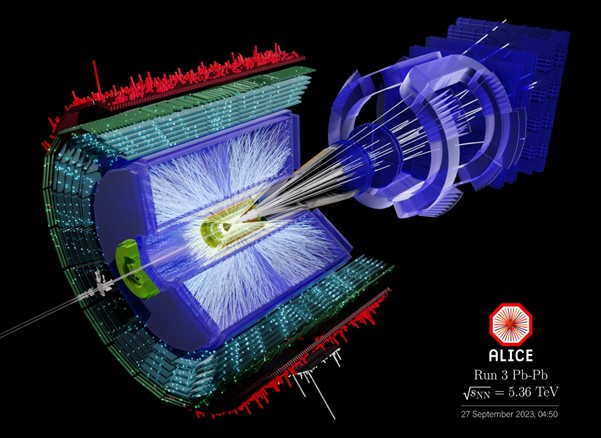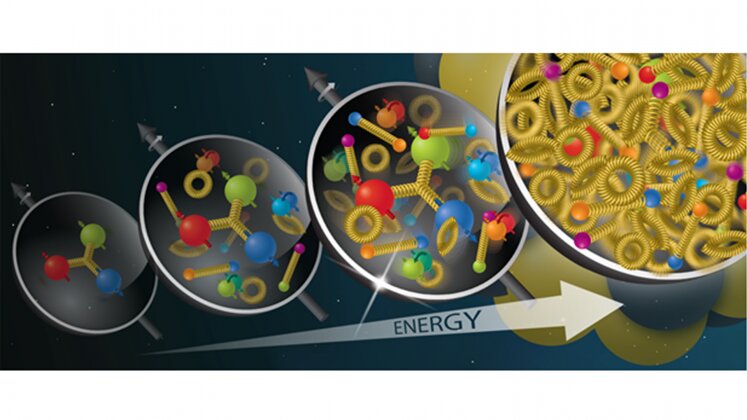Research
My research and that of my group is concerned with the nature of visible matter in the Universe with a focus on understanding the phase equilibria and dynamics of QCD hadronic matter at high temperature and vanishing net baryon density with heavy-flavour, jet and jet substructure probes.
My group leads new measurements which exploit the unique opportunities offered by the ALICE experiment (and future upgrades) at the CERN Large Hadron Collider (near Geneva, Switzerland) while also planning a new experimental programme at the future Electron-Ion Collider (to be built at Brookhaven National Laboratory in the USA).
Underpinning my physics research is the engagement of my group in the development of new silicon detector technologies for high-energy particle vertexing and tracking. This activity makes use of the state-of-the-art departmental facilities, such as the Liverpool Semiconductor Detector Centre (LSDC) and builds on decades of expertise in large area Silicon particle detectors in the department.
For enquiries about PhD or post-doctoral research please contact me at m.chartier@liverpool.ac.uk and visit the departmental webpages on Postgraduate and Fellowships opportunities.

The ALICE Experiment at the Large Hadron Collider
For more details and news visit the ALICE Collaboration Web pages
My group currently carries out most of its research at the LHC where lead-lead heavy-ion collisions at ultra-relativistic energies produce partonic matter and the thermodynamics of the medium formed by these strongly interacting particles (the quark-gluon plasma) can be investigated.
The ALICE Collaboration is an international collaboration of approximately 2000 members from 170 institutions in 40 countries. The Liverpool group is well established in ALICE and has been a full member of the collaboration since 2014.
In partnership with STFC Daresbury Laboratory my group recently completed the construction of a significant fraction of Outer Barrel modules and staves for the upgrade of the ALICE Inner Tracking System detector (ITS2), the largest silicon pixel particle detector entirely made of MAPS, Monolithic Active Pixels Sensors (ALPIDE), totalling nearly 13 billion pixels and covering 10 m2, now operating during the LHC Run 3 data taking phase.
ALICE results, produced from proton-proton, proton-lead and lead-lead collision data collected during the first two running periods of the LHC from 2010 to 2018, have been compiled in a review paper 'The ALICE experiment - A journey through QCD'.

The ePIC Experiment at the Electron Ion Collider
For more details and news visit the ePIC and EIC Web pages
My group recently joined the new ePIC international collaboration, consisting of hundreds of scientists and engineers in 171 institutions from 24 countries, to design a new experiment foreseen to be built at the future high-luminosity Electron-Ion Collider. The UK has announced a £58m investment for the EIC project.
The EIC is currently the only future collider approved for construction in the coming decades. It will collide high-energy electron beams with high-energy proton and ion beams at Brookhaven National Laboratory (USA) enabling new experiments to investigate the nature and properties of cold QCD matter e.g. in regions in the nucleon and nuclei where their structure is dominated by gluons.
For such experiments MAPS (Monolithic Active Pixel Sensors) is the only silicon technology capable of satisfying the most demanding particle vertexing and tracking requirements, relying, for example, on increased granularity and lower material budget. Our group is involved in R&D activities of new sensors designed in the 65 nm CMOS technology which will lead to the construction of the SVT detector for the ePIC experiment as well as for upgrades of the ALICE experiment (e.g. ITS3 upgrade and ALICE 3, the next generation heavy ion experiment at the LHC).
The physics case, detector requirements and concepts for the experimental program at the Electron-Ion Collider have been published in the 'EIC Yellow Report'.
Research groups
Research grants
Novel Approaches to Study the Quark-Gluon Plasma
ROYAL SOCIETY
May 2026 - September 2027
Electron-Ion Collider R&D
SCIENCE AND TECHNOLOGY FACILITIES COUNCIL
October 2021 - June 2031
consolidated grant tbc
SCIENCE AND TECHNOLOGY FACILITIES COUNCIL
October 2024 - September 2027
Nuclear Physics Consolidated Grant
SCIENCE AND TECHNOLOGY FACILITIES COUNCIL
October 2017 - March 2022
ALICE Upgrade 2 (Silicon Physicist post)
SCIENCE AND TECHNOLOGY FACILITIES COUNCIL
November 2017 - August 2020
ALICE Upgrade
SCIENCE AND TECHNOLOGY FACILITIES COUNCIL
January 2015 - December 2019
Nuclear Physics Consolidated Grant
SCIENCE AND TECHNOLOGY FACILITIES COUNCIL
August 2014 - December 2018
Nuclear Physics Rolling Grants 2013 (equipment bid)
SCIENCE AND TECHNOLOGY FACILITIES COUNCIL
January 2014 - March 2014
Consolidated nuclear physics grant 2011
SCIENCE AND TECHNOLOGY FACILITIES COUNCIL
August 2011 - July 2015
Nuclear Structure Astrophysics and Reactions (NuSTAR) at FAIR
SCIENCE AND TECHNOLOGY FACILITIES COUNCIL
April 2010 - March 2016
Studies of the Equation of State of Asymmetric Nuclear Matter
SCIENCE AND TECHNOLOGY FACILITIES COUNCIL
October 2010 - October 2013
Studies of the Equation of State of Asymmetric Nuclear Matter
SCIENCE AND TECHNOLOGY FACILITIES COUNCIL
October 2009 - October 2013
Trapped antihydrogen - towards spectroscopy.
ENGINEERING & PHYSICAL SCIENCES RESEARCH COUNCIL
March 2006 - February 2010
Participation in the S306 Experiment at GSI in January 2009
SCIENCE AND TECHNOLOGY FACILITIES COUNCIL
January 2009
Production cross-sections and momentum distributions of neutron-deficient nuclei.
ROYAL SOCIETY (CHARITABLE)
May 2004 - July 2004
European nuclear structure integrated infrastructure initiative (EURONS).
EUROPEAN COMMISSION
January 2005 - December 2008
Nuclear Physics Rolling Grant
SCIENCE AND TECHNOLOGY FACILITIES COUNCIL
August 2008 - August 2011
Studies of light weakly-bound neutron-rich nuclei by nucleon-knockout reactions.
SCIENCE AND TECHNOLOGY FACILITIES COUNCIL
July 2004 - January 2008
Research collaborations
ALICE Collaboration
CERN/LHC
ALICE experiment at CERN/LHC
ePIC Collaboration
EIC/BNL
ePIC experiment at EIC (BNL, USA)